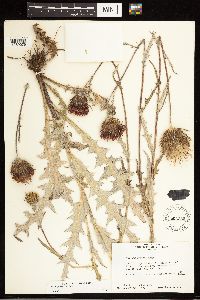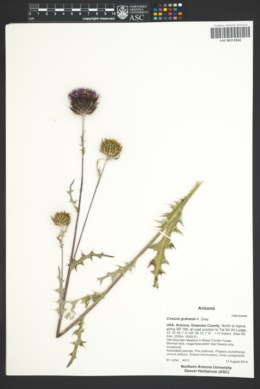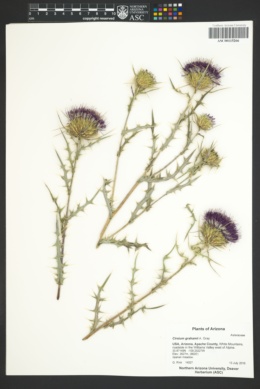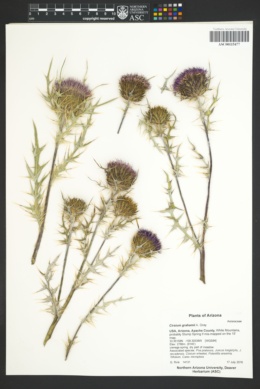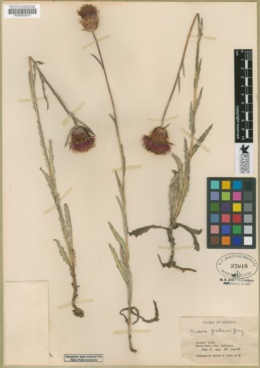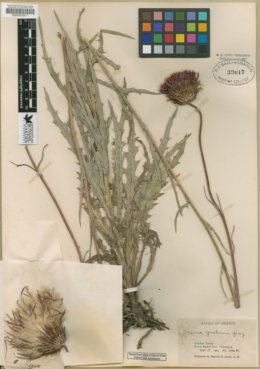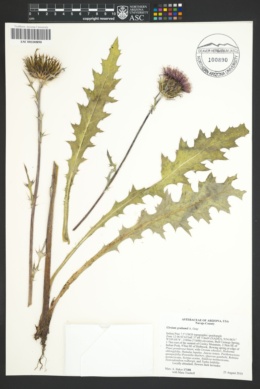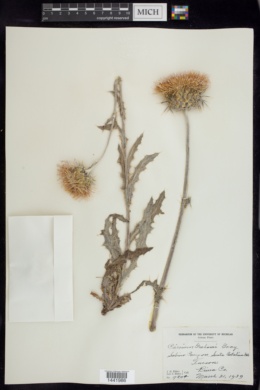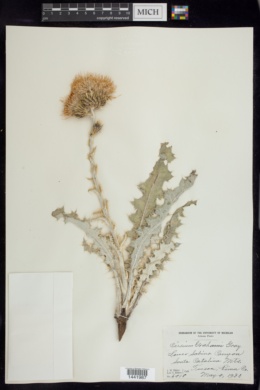Cirsium grahamii
|
|
|
|
Family: Asteraceae
Graham's Thistle
[Cnicus grahamii A. Gray] |
Biennials, 50-100 cm; taproots slender and fascicles of thick fibrous roots. Stems 1, erect, thinly arachnoid and/or puberulent to short-pilose, sometimes ± glabrate; branches 0-4, ascending. Leaves: blades oblanceolate to oblong-elliptic, 20-30 × 3-8 cm, spinulose and otherwise entire or coarsely dentate to deeply pinnatifid, lobes entire or coarsely few toothed or lobed, main spines slender, 3-6 mm, abaxial ± persistently gray-tomentose, sometimes pilose along veins, adaxial faces thinly arachnoid and ± glabrate; basal often present at flowering, sessile or narrowly winged-petiolate; principal cauline gradually winged-petiolate or sessile, reduced distally, bases sometimes clasping or short-decurrent; distal cauline ascending, becoming bractlike, narrow, lobed or not. Heads 1-5. Peduncles 10-30 cm. Involucres hemispheric, 2-3 × 2-4 cm, thinly arachnoid or glabrous. Phyllaries in ca. 8 series, imbricate, proximally brownish, distally dark purplish, lanceolate to linear, margins of outer hispidulous-ciliolate, spiny fringed, pinnately spiny or with scarious appendages, abaxial faces with prominent, glutinous ridge; outer and middle appressed or only apices spreading, bodies minutely spinulose-denticulate, spines erect to ascending, 1.5-2.5 mm; apices of inner phyllaries often flexuous, flat, scabridulous. Corollas deep purple, 22-30 mm, tubes 13-18 mm, throats 4-5 mm, lobes 5-8 mm; style tips 4-4.5 mm. Cypselae tan with dark speckles to dark purplish brown, 4-5.5 mm, apical collars not differently colored; pappi 13-18 mm. 2n = 32 (Mexico). Flowering Jul-Sep. Oak woodlands, coniferous forests, meadows, often in damp soil; 1400-2600 m; Ariz., N.Mex.; Mexico (Chihuahua, Durango, Sonora). Cirsium grahamii occurs in the mountains of southeastern Arizona and southwestern New Mexico. It forms hybrid swarms with C. parryi and C. scariosum var. coloradense in the White Mountains of Arizona.
FNA 2006, Kearney and Peebles 1969, McDougall 1973 Duration: Perennial Nativity: Native Lifeform: Forb/Herb General: Herbaceous biennials to perennials, to 1 m tall, stems solitary, erect, branches 0-4, ascending, surfaces thinly arachnoid and puberulent to short-pilose, sometimes glabrate, plants arising from slender taproots and fascicles of thick fibrous roots. Leaves: Spiny, alternate, blades oblanceolate to oblong-elliptic, 20-30 cm long and 3-8 cm wide, margins spinulose and otherwise entire or coarsely dentate to deeply pinnatifid, lobes entire or coarsely few toothed or lobed, main spines slender, 3-6 mm long, persistently gray-tomentose below, sometimes pilose along veins, faces thinly arachnoid and glabrate; basal often present at flowering, sessile or narrowly winged-petiolate, principal cauline gradually winged-petiolate or sessile, becoming reduced distally, bases sometimes clasping or short-decurrent, distal cauline ascending, becoming bractlike, narrow, lobed or not. Flowers: Deep purple, clustered in large and showy discoid heads, disk florets in groups of 1-5, corollas 22-30 mm long, tubes 13-18 mm long, throats 4-5 mm long, lobes 5-8 mm long, involucres hemispheric, 2-3 cm long and 2-4 cm wide, surfaces thinly arachnoid to glabrous, phyllaries linear to lanceolate, in about 8 series, overlapping (imbricate), bases brownish, tips dark purplish, margins of outer minutely bristly, spiny fringed, pinnately spiny or with scarious appendages, spines erect to ascending, 1.5-2.5 mm long, outer and middle phyllaries appressed or only apices spreading, bodies minutely spinulose-denticulate, with prominent, glutinous ridges on the undersides, apices of inner phyllaries often flexuous, flat and lightly scaly, style tips 4-4.5 mm, flowering heads borne on peduncles 10-30 cm long. Fruits: Cypselae (achenes) tan with dark speckles to dark purplish brown, 4-5.5 mm long, ovoid and compressed with apical rims, faces smooth, glabrous, not ribbed, basal attachment scars slightly angled, apical collars not differently colored. Pappi in 3-5 series Ecology: Found on damp soils in oak woodlands, coniferous forests, openings in pine forests, and meadows, from 4,500-8,500 ft (1372-2591 m); flowering July-September. Distribution: Arizona, New Mexico; Mexico. Synonyms: None Editor: LCrumbacher2012 Etymology: Cirsium is derived from the Greek kirsion, "a kind of thistle," in turn from kirsos, "a swollen vein or welt," because thistles were often used as a remedy against such things, while grahamii is after James Duncan Graham (1799-1865). |





























